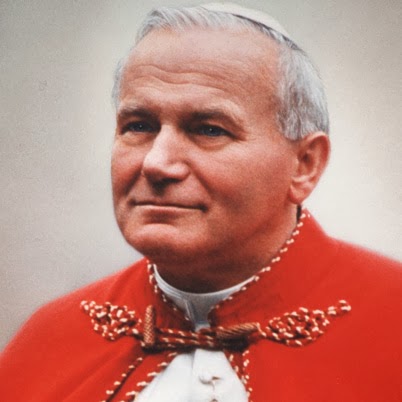On July 4, 1958, he was appointed titular bishop of Ombi and
auxiliary of Krakow by Pope Pius XII, and was consecrated September
28, 1958, in Wawel Cathedral, Krakow, by Archbishop Eugeniusz
Baziak.
On January 13, 1964, he was appointed archbishop of Krakow by Pope
Paul VI, who made him a cardinal June 26, 1967 with the title of S.
Cesareo in Palatio of the order of deacons, later elevated pro illa
vice to the order of priests.
Besides taking part in Vatican Council II (1962-1965) where he made
an important contribution to drafting the Constitution Gaudium et
spes, Cardinal Wojtyła participated in all the assemblies of the
Synod of Bishops.
The Cardinals elected him Pope at the Conclave of 16 October 1978,
and he took the name of John Paul II. On 22 October, the Lord's Day,
he solemnly inaugurated his Petrine ministry as the 263rd successor
to the Apostle. His pontificate, one of the longest in the history
of the Church, lasted nearly 27 years.
Driven by his pastoral solicitude for all Churches and by a sense of
openness and charity to the entire human race, John Paul II
exercised the Petrine ministry with a tireless missionary spirit,
dedicating it all his energy. He made 104 pastoral visits outside
Italy and 146 within Italy. As bishop of Rome he visited 317 of the
city's 333 parishes.
He had more meetings than any of his predecessors with the People of
God and the leaders of Nations. More than 17,600,000 pilgrims
participated in the General Audiences held on Wednesdays (more than
1160), not counting other special audiences and religious ceremonies
[more than 8 million pilgrims during the Great Jubilee of the Year
2000 alone], and the millions of faithful he met during pastoral
visits in Italy and throughout the world. We must also remember the
numerous government personalities he encountered during 38 official
visits, 738 audiences and meetings held with Heads of State, and 246
audiences and meetings with Prime Ministers.
His love for young people brought him to establish the World Youth
Days. The 19 WYDs celebrated during his pontificate brought together
millions of young people from all over the world. At the same time
his care for the family was expressed in the World Meetings of
Families, which he initiated in 1994.
John Paul II successfully encouraged dialogue with the Jews and with
the representatives of other religions, whom he several times
invited to prayer meetings for peace, especially in Assisi.
Under his guidance the Church prepared herself for the third
millennium and celebrated the Great Jubilee of the year 2000 in
accordance with the instructions given in the Apostolic Letter
Tertio Millennio adveniente. The Church then faced the new epoch,
receiving his instructions in the Apostolic Letter Novo Millennio
ineunte, in which he indicated to the faithful their future path.
With the Year of the Redemption, the Marian Year and the Year of the
Eucharist, he promoted the spiritual renewal of the Church.
He gave an extraordinary impetus to Canonizations and
Beatifications, focusing on countless examples of holiness as an
incentive for the people of our time. He celebrated 147
beatification ceremonies during which he proclaimed 1,338 Blesseds;
and 51 canonizations for a total of 482 saints. He made Thérèse of
the Child Jesus a Doctor of the Church.
He considerably expanded the College of Cardinals, creating 231
Cardinals (plus one in pectore) in 9 consistories. He also called
six full meetings of the College of Cardinals.
He organized 15 Assemblies of the Synod of Bishops - six Ordinary
General Assemblies (1980, 1983, 1987, 1990, 1994 and 2001), one
Extraordinary General Assembly (1985) and eight Special Assemblies
(1980,1991, 1994, 1995, 1997, 1998 (2) and 1999).
His most important Documents include 14 Encyclicals, 15 Apostolic
Exhortations, 11 Apostolic Constitutions, 45 Apostolic Letters.
He promulgated the Catechism of the Catholic Church in the light of
Tradition as authoritatively interpreted by the Second Vatican
Council. He also reformed the Eastern and Western Codes of Canon
Law, created new Institutions and reorganized the Roman Curia.
As a private Doctor he also published five books of his own:
"Crossing the Threshold of Hope" (October 1994), "Gift and Mystery,
on the fiftieth anniversary of my ordination as priest" (November
1996), "Roman Triptych" poetic meditations (March 2003), "Arise, Let
us Be Going" (May 2004) and "Memory and Identity" (February 2005).
In the light of Christ risen from the dead, on 2 April a.D. 2005, at
9.37 p.m., while Saturday was drawing to a close and the Lord's Day
was already beginning, the Octave of Easter and Divine Mercy Sunday,
the Church's beloved Pastor, John Paul II, departed this world for
the Father.
From that evening until April 8, date of the funeral of the late
Pontiff, more than three million pilgrims came to Rome to pay homage
to the mortal remains of the Pope. Some of them queued up to 24
hours to enter St. Peter's Basilica.
On April 28, the Holy Father Benedict XVI announced that the normal
five-year waiting period before beginning the cause of beatification
and canonization would be waived for John Paul II. The cause was
officially opened by Cardinal Camillo Ruini, vicar general for the
diocese of Rome, on June 28 2005.





No comments:
Post a Comment